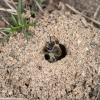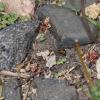Chasing fireflies through the dark, zigzagging across a humid lawn trying to anticipate where they would flash next is one of my favorite childhood memories. Despite growing up west of the Rockies where flashing firefly species are rarely found, I was introduced to them on trips to visit family out east. Like many kids, I was transfixed with the magic of their glow slowly lifting into the air at dusk. The flash of fireflies marks the onset of summer in many parts of the country.
As summer winds down and fall begins, you’ll notice fewer insects flying through the air and crawling on your plants. But they are still there, just less visible, hidden below insulating leaf litter or tucked into hollow stems. The showy adult stages that are often the most noticeable – like flashing fireflies – seemingly disappear. Though the adults of many invertebrate species do die off, in most cases their offspring overwinter exactly where they spend the summer – right in your yard. This is the case with fireflies. Almost all types of fireflies spend the majority of their lives in or at the soil surface (up to two years!). Their eggs and larvae generally develop in the soil, and fireflies pupate underground, in rotting wood, or even tucked into fissures of tree bark.
Like many other insects, fireflies are at risk, and pesticides are a leading threat to North American populations. It’s essential to understand the life history of an insect to protect it from pesticide exposure, as we often miss significant risks if we just focus on the flashy adult lifestage. There are several common home pesticide uses that are particularly risky to fireflies because of their behavior and life history.

Risks from Pesticides
Lawn Treatments
Since fireflies spend so much time underground, this means pesticide applications to the soil, like broadcast lawn treatments, are particularly risky to these species. Because their eggs and larvae can take months to years to develop, fireflies can be exposed to these treatments multiple times, further increasing the risk. These applications are often sneaky: insecticides are sometimes included in multipurpose fertilizer products, often called “weed-and-feed”. Highly toxic insecticides are often used in lawn treatments to kill beetle grubs. Chemicals used include pyrethroids, neonicotinoids, and chlorantraniliprole, a newer insecticide. These insecticides are broad spectrum, meaning they are deadly to many insects, including fireflies.
Mosquito Sprays
Another hidden source of pesticide exposure to fireflies is residential mosquito sprays. Stepping back, you might wonder “Where do adult fireflies live when they aren’t flying at dusk?” Again, the answer is right in your yard! Adult fireflies often shelter in vegetation like garden shrubs during the day. In many regions of the country where fireflies live, home owners hire residential mosquito spray services. These companies target vegetation around the yard when spraying insecticides to kill adult mosquitoes, and frequently use broadly toxic pyrethroids. These are the exact areas often harboring fireflies.

What You Can Do
What can you do to protect fireflies from pesticide exposure at home?
- Don’t use insecticide lawn treatments. Instead, try to change the conditions so that pests can't flourish. For grubs, this might include changing watering practices and mowing turf higher to encourage deep root growth. Reduce pesticide use overall.
- Use alternatives to synthetic fertilizers. Research also suggests that fertilizers themselves can be toxic to firefly larvae! Consider adding diversity to your yard, like clover, to fix nitrogen.
- Don’t spray for adult mosquitoes. While mosquitoes can be concerning, there are better ways to control mosquitoes at home. Take time to remove standing water, even small containers, that serve as breeding grounds for mosquitoes. Clogged gutters can be a surprise source of water.
- View your yard as habitat for fireflies and other invertebrates! Recognize that some feeding damage is a sign your yard is providing resources for invertebrates.
Invertebrates, including fireflies, are able to use small patches of habitat in urban areas, like our home yards. By protecting these areas from pesticides, we can ensure that the habitat we’re creating is high quality and not exposing the very species we’re trying to conserve from unnecessary risks.





